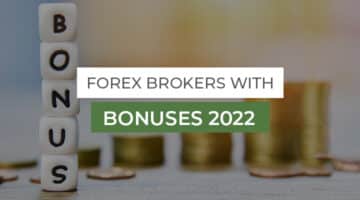Best Leverage for Small Account

In this article
One of the reasons many traders like forex trading is the use of leverage. Unlike stock or other markets, forex presents you with much greater leverage.
However, it is a double-edged sword, and it becomes more important when you have a small account.
So, in this guide, we’ll tell you what the best leverage for small account is.
What is forex leverage?
First, let’s explain what forex leverage is.
Using leverage, a forex broker allows you to buy more with fewer funds. Consider it an instrument that gives you the option to acquire more.
Your forex broker provides you with fixed-ratio leverage. Every broker has a different definition of leverage, so double-check before you use it.
The main emphasis is on forex brokers, as they are the ones that supply you with leverage. They enable margin trading in FX. Brokers often provide leverage of 1:5 to 1:3000.
To buy or sell 5000 units of USD/CAD without leverage, for example, you would need to deposit $5000 in your account. However, with leverage of 1:100, however, all you need is $50 to go long or short on the pair.
The challenge is that many new traders are enticed to use the maximum level of leverage available. Unfortunately, for small account users, the maximum forex leverage isn’t always ideal.
High leverage can be beneficial, but only when applied properly. New traders frequently use leverage to open larger positions in order to gain greater and quicker returns from their trades.
The disadvantage is that each time a position does not perform as predicted, a higher loss means less margin for the following trade, and so on.
Best leverage for small account
Now that you understand the concept of leverage, the question popping in your head would be, what is the best leverage for me if I have a small account?
Before using leverage, ask yourself, are you a day trader, a swing trader, a position trader, an intra-day trader, or a scalper? Do you like to trade conservatively or aggressively?
Let’s break it down.
A 1:100 leverage signifies that if you have $10 in your account, you can make a $10,000 trade. This is what attracts many traders, as you have the opportunity to make a large profit without risking your actual money.
A key point to note is that your brokers do not issue huge leverages out of the goodness of their hearts; they need some form of security or insurance.
Your broker will put aside $100 from your forex account to manage a $10,000 position. Your leverage is 1:100. As a result, with $100, you can trade $10,000.
The $10 is the minimum amount required in your account to initiate a $10,000 trade with a leverage of 1:100.
Margin is the term for this amount. To open leveraged positions, your broker will request a good faith deposit from you.
The term “margin” refers to a percentage of a certain sum. Depending on the leverage you utilise, many brokers have margin requirements of 1 or 2 percent. Brokers who provide a high leverage, such as 1:1000, demand less margin.
For example, in our 1:100 leverage scenario above, the margin requirement was 1%. The more leverage you utilise, the higher the risk to your money.
That scenario would be drastically different if you put $500 into your trading account. Any temporary drop would handle itself with a free margin.
On the other hand, inexperienced traders frequently use this extra wiggle room to start more positions or raise the size of their existing positions.
Pro Tips for using leverage
Avoid scalping and intra-day trading when it comes to leverage. The temptation to use large leverage to generate rapid money on single trades is appealing, but the risks aren’t worth it. This is especially true in light of the future’s unpredictability.
There is no optimal leverage; however, we recommend using lower leverage on a small trading account and trading small volumes as a beginner. Likewise, you educate yourself and develop your trading strategy.
Trading with a 1% risk rule gives a small account the same level of protection (against mistakes and unexpected losses) as a large one.
Because it is a very successful risk management approach, many expert traders use the 1% risk rule regardless of the size of their trading accounts.
Assume a trader manages his or her money carefully, risking only 1% of his or her account balance every transaction and only making one trade. In that case, you can have your account from wiping out if things go south.
If you are a beginner, you need to exercise caution when it comes to risk. You should aim for a ratio of 1:10 to 1:50 and no more. You will learn to handle your trade as well as your emotions and psychology in this manner.
Pros of using leverage
- You only need a small amount of money to get started, and leverage may help you raise your profits.
- Leverage is a useful tool for dealing with low market volatility.
- In forex, leverage allows you to profit from both long and short bets.
- Because the forex market is open 24 hours a day, you may use leverage to increase your profits.
- Leverage can help you earn more money in a shorter amount of time.
Cons of using leverage
- Leverage’s greatest and most feared downside is its tendency to multiply losses during market volatility.
- The size of your trade or your trading account balance does not affect your risk in leveraged positions.
- If your margin needs exceed your trading balance, your broker may demand further deposits to cover the agreed margin requirement, which is known as a margin call.
Bottom line
Whatever your style is, keep in mind that just because leverage exists doesn’t mean you have to use it.
Generally speaking, the less leverage you apply, the better. It takes a lot of practice to truly understand when to apply leverage and when not to. You’ll be able to stay in the game for the long term if you remain careful.
Jason Morgan is an experienced forex analyst and writer with a deep understanding of the financial markets. With over 13+ years of industry experience, he has honed his skills in analyzing and forecasting currency movements, providing valuable insights to traders and investors.
Forex Content Writer | Market Analyst
Relevant Posts

Forex Brokers with Bonuses 2022
[top_three_brokers] What are the leading and best forex brokers with bonuses 2022 or promotions to…
Read more

Deriv MT4
[top_three_brokers] [single_affiliate title="" id="6070" size="big"] Deriv broker aims to offer its consumers a wide-ranged online…
Read more

What is Day Trading in forex?
[top_three_brokers] Do you know what is day trading in forex? A single trading day is…
Read more

FXTM MT4 – MetaTrader 4
[top_three_brokers] [single_affiliate title="" id="3896" size="big"] As we talk about the FXTM MT4 (MetaTrader 4) trading…
Read more

Exness MT4 – MetaTrader 4
[top_three_brokers] [single_affiliate title="" id="3178" size="big"] To start trading with the Exness MT4, you must first…
Read more
Retracement Forex
[top_three_brokers] You hear a lot about Forex withdrawals, especially if you have to sell them.…
Read more

Deriv Real Account Registration
[top_three_brokers] [single_affiliate title="" id="6070" size="big"] Deriv is a globally known trading services provider platform in…
Read more

Why Should You enjoy Forex Trading?
[top_three_brokers] Forex Trading has been around for many years, dominating the markets and growing each…
Read more

Why is the Forex Market Open 24 Hours a Day?
[top_three_brokers] If you have already started the investment ride, the forex market is a familiar…
Read more

Deriv MT5
[top_three_brokers] [single_affiliate title="" id="6070" size="big"] DMT5 originated as MetaTrader 5 (MT5) is an online trading…
Read more

Forex Brokers with Bonuses 2022
[top_three_brokers] What are the leading and best forex brokers with bonuses 2022 or promotions to…

Deriv MT4
[top_three_brokers] [single_affiliate title="" id="6070" size="big"] Deriv broker aims to offer its consumers a wide-ranged online…

What is Day Trading in forex?
[top_three_brokers] Do you know what is day trading in forex? A single trading day is…

FXTM MT4 – MetaTrader 4
[top_three_brokers] [single_affiliate title="" id="3896" size="big"] As we talk about the FXTM MT4 (MetaTrader 4) trading…

Exness MT4 – MetaTrader 4
[top_three_brokers] [single_affiliate title="" id="3178" size="big"] To start trading with the Exness MT4, you must first…
Retracement Forex
[top_three_brokers] You hear a lot about Forex withdrawals, especially if you have to sell them.…

Deriv Real Account Registration
[top_three_brokers] [single_affiliate title="" id="6070" size="big"] Deriv is a globally known trading services provider platform in…

Why Should You enjoy Forex Trading?
[top_three_brokers] Forex Trading has been around for many years, dominating the markets and growing each…

Why is the Forex Market Open 24 Hours a Day?
[top_three_brokers] If you have already started the investment ride, the forex market is a familiar…

Deriv MT5
[top_three_brokers] [single_affiliate title="" id="6070" size="big"] DMT5 originated as MetaTrader 5 (MT5) is an online trading…


